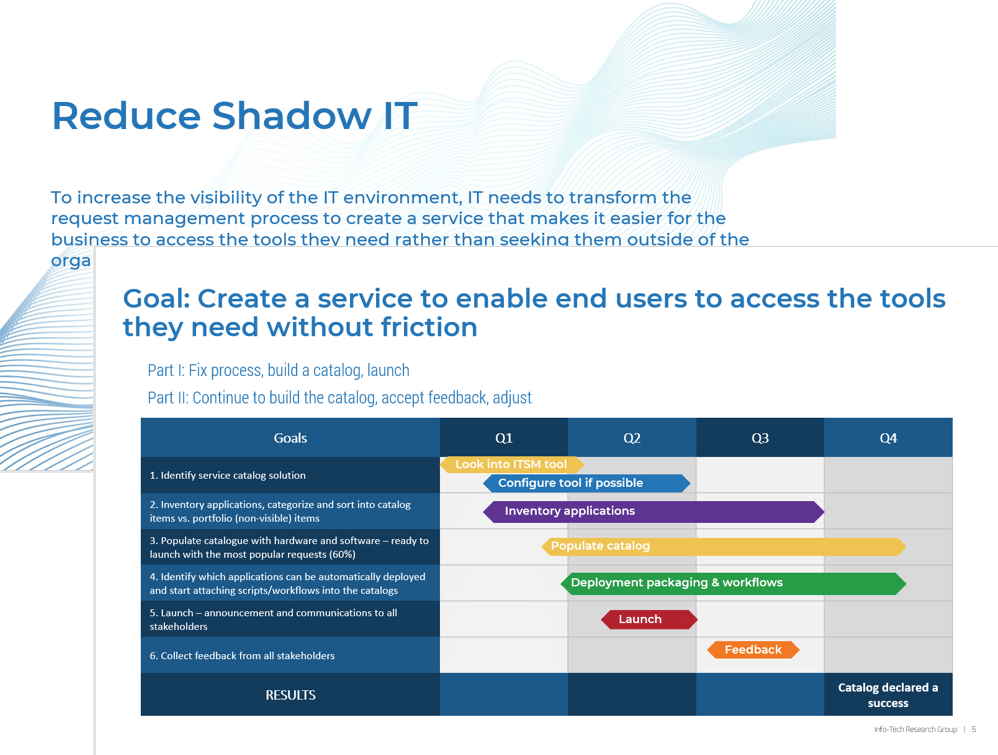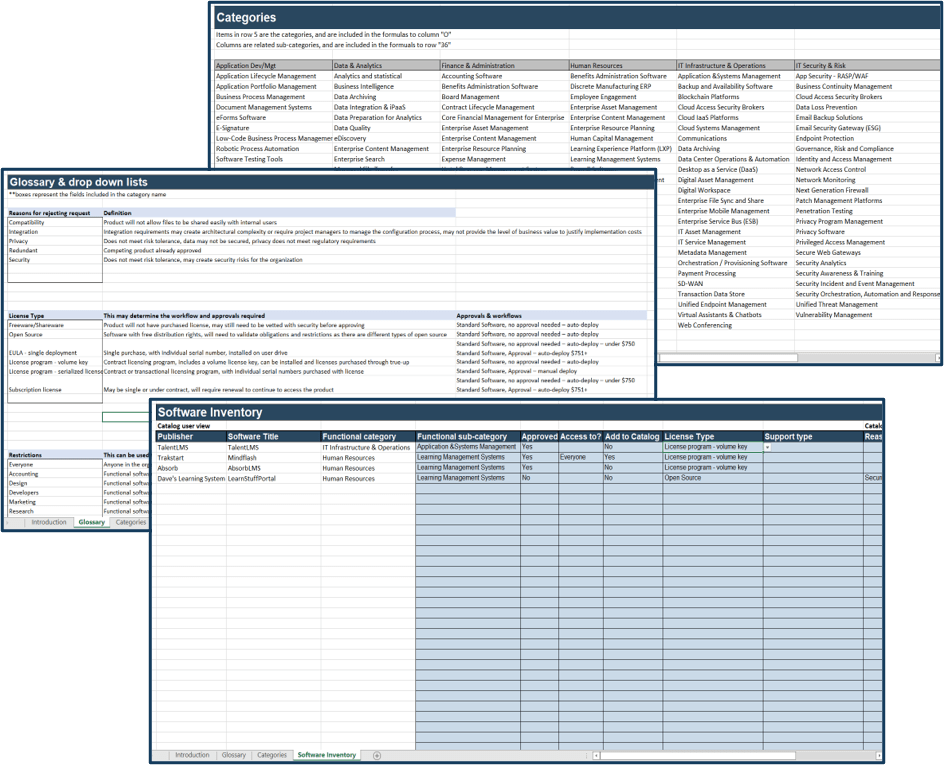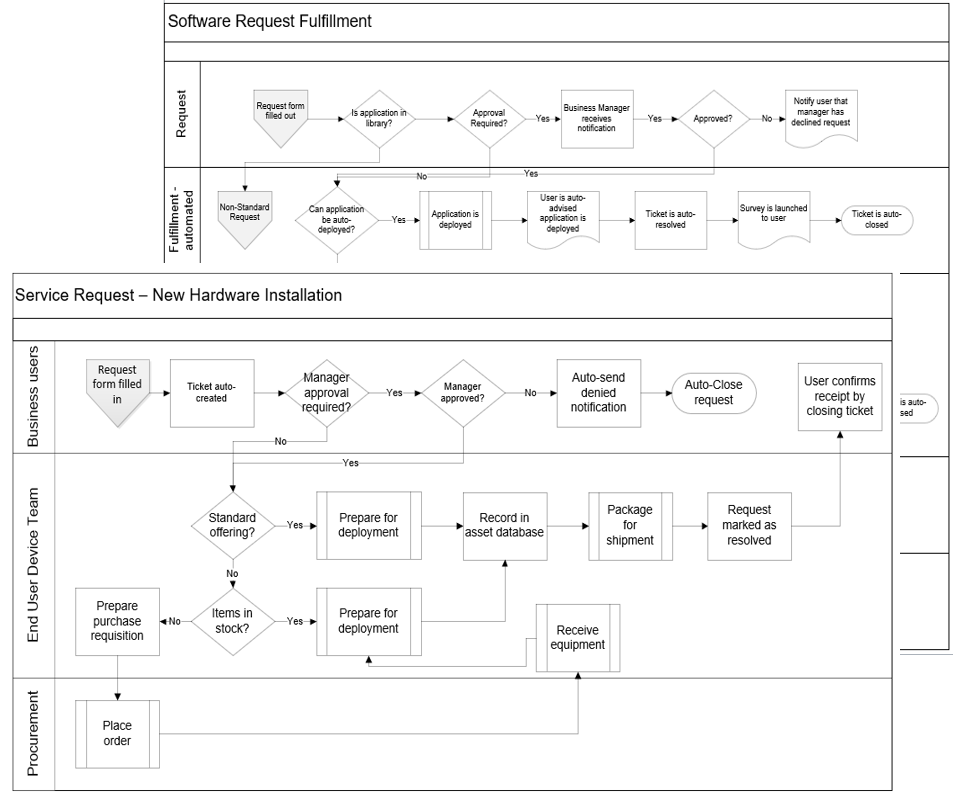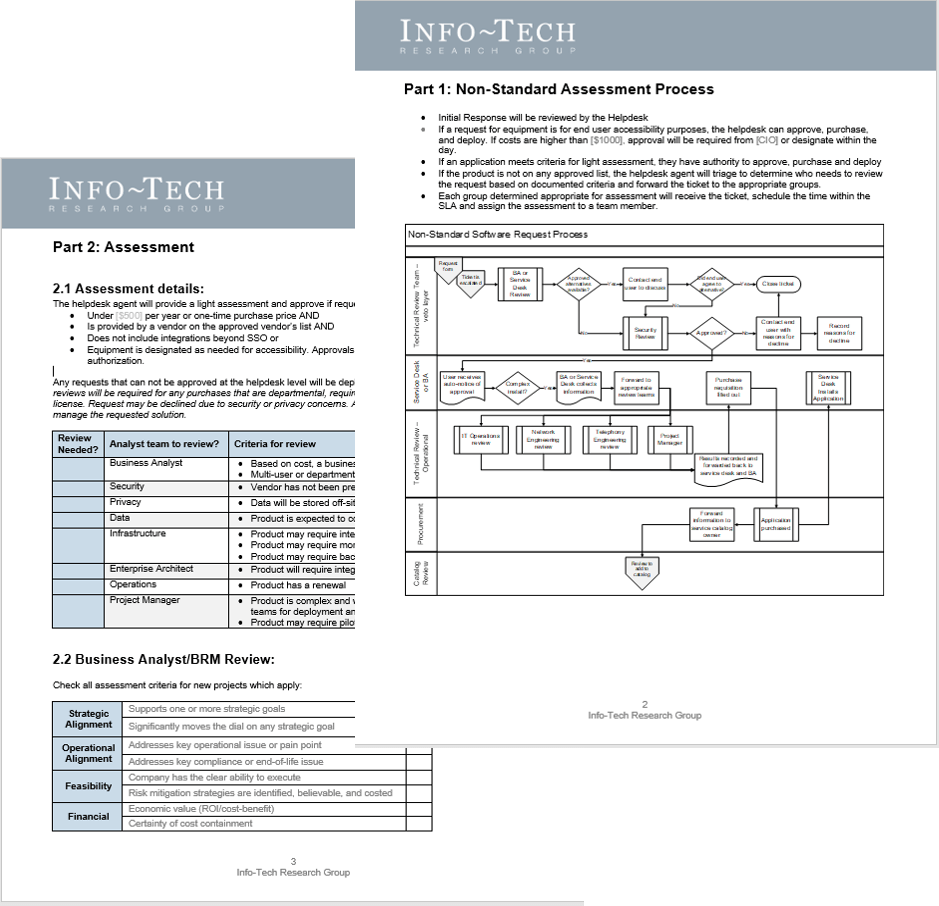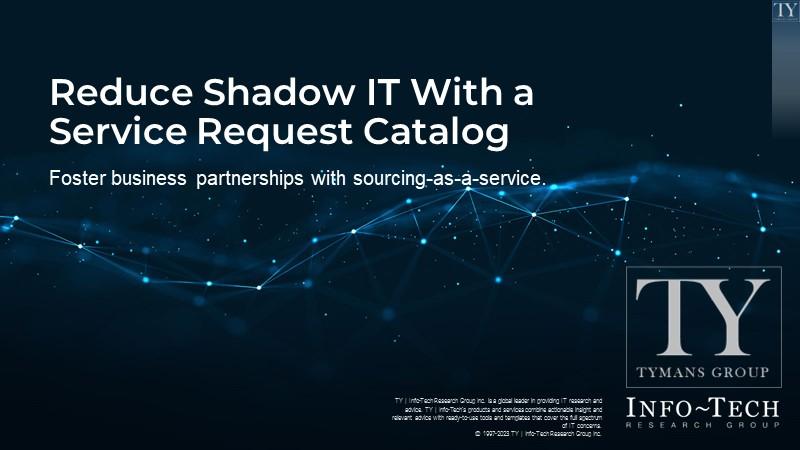
Reduce Shadow IT With a Service Request Catalog
- Shadow IT: The IT team is regularly surprised to discover new products within the organization, often when following up on help desk tickets or requests for renewals from business users or vendors.
- Renewal Management: The contracts and asset teams need to be aware of upcoming renewals and have adequate time to review renewals.
- Over-purchasing: Contracts may be renewed without a clear picture of usage, potentially renewing unused applications.
Our Advice
Critical Insight
There is a direct correlation between service delivery dissatisfaction and increases in shadow IT. Whether the goal is to reduce shadow IT or gain control, improved customer service and fast delivery are key to making lasting changes.
Impact and Result
Our blueprint will help you design a service that draws the business to use it. If it is easier for them to buy from IT than it is to find their own supplier, they will use IT.
A heavy focus on customer service, design optimization, and automation will provide a means for the business to get what they need, when they need it, and provide visibility to IT and security to protect organizational interests.
This blueprint will help you:
- Design the request service
- Design the request catalog
- Build the request catalog
- Market the service
Reduce Shadow IT With a Service Request Catalog Research & Tools
Besides the small introduction, subscribers and consulting clients within this management domain have access to:
1. Reduce Shadow IT With a Service Request Catalog – A step-by-step document that walks you through creation of a request service management program.
Use this blueprint to create a service request management program that provides immediate value.
- Reduce Shadow IT With a Service Request Catalog Storyboard
2. Nonstandard Request Assessment – A template for documenting requirements for vetting and onboarding new applications.
Use this template to define what information is needed to vet and onboard applications into the IT environment.
- Nonstandard Request Assessment
3. Service Request Workflows – A library of workflows used as a starting point for creating and fulfilling requests for applications and equipment.
Use this library of workflows as a starting point for creating and fulfilling requests for applications and equipment in a service catalog.
- Service Request Workflows
4. Application Portfolio – A template to organize applications requested by the business and identify which items are published in the catalog.
Use this template as a starting point to create an application portfolio and request catalog.
- Application Portfolio
5. Reduce Shadow IT With a Service Request Catalog Communications Template – A presentation and communications plan to announce changes to the service and introduce a catalog.
Use this template to create a presentation and communications plan for launching the new service and service request catalog.
- Reduce Shadow IT with a Service Request Catalog Communications Template
Workshop: Reduce Shadow IT With a Service Request Catalog
Workshops offer an easy way to accelerate your project. If you are unable to do the project yourself, and a Guided Implementation isn't enough, we offer low-cost delivery of our project workshops. We take you through every phase of your project and ensure that you have a roadmap in place to complete your project successfully.
1 Design the Service
The Purpose
Collaborate with the business to determine service model.
Collaborate with IT teams to build non-standard assessment process.
Key Benefits Achieved
Designed a service for service requests, including new product intake.
Activities
1.1 Identify challenges and obstacles.
1.2 Complete customer journey map.
1.3 Design process for nonstandard assessments.
Outputs
Nonstandard process.
2 Design the Catalog
The Purpose
Design the service request catalog management process.
Key Benefits Achieved
Ensure the catalog is kept current and is integrated with IT service catalog if applicable.
Activities
2.1 Determine what will be listed in the catalog.
2.2 Determine process to build and maintain the catalog, including roles, responsibilities, and workflows.
2.3 Define success and determine metrics.
Outputs
Catalog scope.
Catalog design and maintenance plan.
Defined success metrics
3 Build and Market the Catalog
The Purpose
Determine catalog contents and how requests will be fulfilled.
Key Benefits Achieved
Catalog framework and service level agreements will be defined.
Create communications documents.
Activities
3.1 Determine how catalog items will be displayed.
3.2 Complete application categories for catalog.
3.3 Create deployment categories and SLAs.
3.4 Design catalog forms and deployment workflows.
3.5 Create roadmap.
3.6 Create communications plan.
Outputs
Catalog workflows and SLAs.
Roadmap.
Communications deck.
4 Breakout Groups – Working Sessions
The Purpose
Create an applications portfolio.
Prepare to populate the catalog.
Key Benefits Achieved
Portfolio and catalog contents created.
Activities
4.1 Using existing application inventory, add applications to portfolio and categorize.
4.2 Determine which applications should be in the catalog.
4.3 Determine which applications are packaged and can be easily deployed.
Outputs
Application Portfolio.
List of catalog items.
Further reading
Reduce Shadow IT With a Service Request Catalog
Foster business partnerships with sourcing-as-a-service.
Analyst Perspective
Improve the request management process to reduce shadow IT.
In July 2022, Ivanti conducted a study on the state of the digital employee experience, surveying 10,000 office workers, IT professionals, and C-suite executives. Results of this study indicated that 49% of employees are frustrated by their tools, and 26% of employees were considering quitting their jobs due to unsuitable tech. 42% spent their own money to gain technology to improve their productivity. Despite this, only 21% of IT leaders prioritized user experience when selecting new tools.
Any organization’s workers are expected to be productive and contribute to operational improvements or customer experience. Yet those workers don’t always have the tools needed to do the job. One option is to give the business greater control, allowing them to choose and acquire the solutions that will make them more productive. Info-Tech's blueprint Embrace Business-Managed Applications takes you down this path.
However, if the business doesn’t want to manage applications, but just wants have access to better ones, IT is positioned to provide services for application and equipment sourcing that will improve the employee experience while ensuring applications and equipment are fully managed by the asset, service, and security teams.
Improving the request management and deployment practice can give the business what they need without forcing them to manage license agreements, renewals, and warranties.

Sandi Conrad
ITIL Managing Professional
Principal Research Director, IT Infrastructure & Operations,
Info-Tech Research Group
Your challenge
This research is designed to help organizations that are looking to improve request management processes and reduce shadow IT.
Shadow IT: The IT team is regularly surprised to discover new products within the organization, often when following up on help desk tickets or requests for renewals from business users or vendors.
Renewal management: The contracts and asset teams need to be aware of upcoming renewals and have adequate time to review renewals.
Over-purchasing and over-spending: Contracts may be renewed without a clear picture of utilization, potentially renewing unused applications. Applications or equipment may be purchased at retail price where corporate, government, or educational discounts exist.
Info-Tech Insight
To increase the visibility of the IT environment, IT needs to transform the request management process to create a service that makes it easier for the business to access the tools they need rather than seeking them outside of the organization.
|
609
|
40%
|
— Source: Zylo, SaaS Trends for IT Leaders, 2022
Common obstacles
Too many layers of approvals and a lack of IT workers makes it difficult to rethink service request fulfillment.
Delays: The business may not be getting the applications they need from IT to do their jobs or must wait too long to get the applications approved.
Denials: Without IT’s support, the business is finding alternative options, including SaaS applications, as they can be bought and used without IT’s input or knowledge.
Threats: Applications that have not been vetted by security or installed without their knowledge may present additional threats to the organization.
Access: Self-serve isn’t mature enough to support an applications catalog.
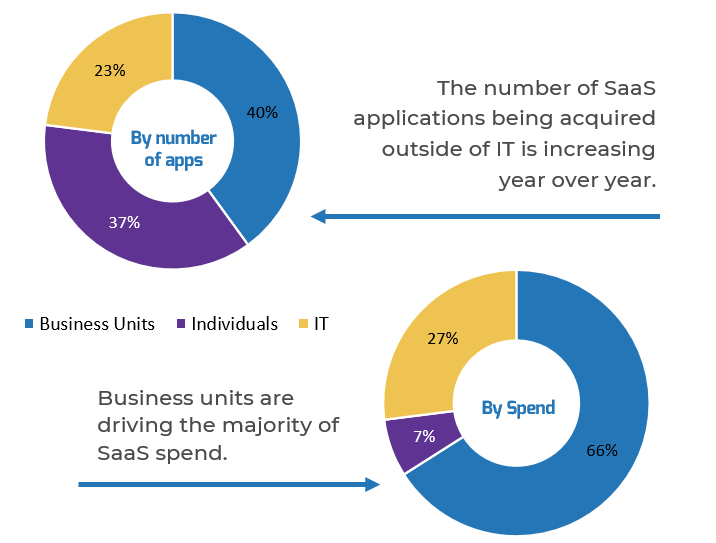
8: average number of applications entering the organization every 30 days
— Source: Zylo, SaaS Trends for Procurement, 2022
Info-Tech’s approach
Improve the request management process to create sourcing-as-a-service for the business.
- Improve customer service
- Reduce shadow IT
- Gain control in a way that keeps the business happy
|
1. Design the service Collaborate with the business Identify the challenges and obstacles Gain consensus on priorities Design the service |
2. Design the catalog Determine catalog scope Create a process to build and maintain the catalog Define metrics for the request management process |
3. Build the catalog Determine descriptions for catalog items Create definitions for license types, workflows, and SLAs Create application portfolio Design catalog forms and workflows |
4. Market the service Create a roadmap Determine messaging Build a communications plan |
Blueprint deliverables
Each step of this blueprint is accompanied by supporting deliverables to help you accomplish your goals:
|
Communications Presentation
|
Application Portfolio
|
Visio Library
|
Nonstandard Request Assessment
|
Create a request management process and service catalog to improve delivery of technology to the business
